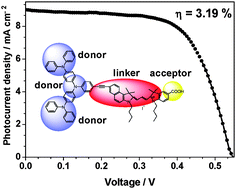A new starburst triphenylamine-based unsymmetrical organic cyanine sensitizer I and the corresponding cyanine dye II containing one triphenylamine unit for the purpose of comparison were designed and synthesized. They were successfully applied in quasi-solid-state dye-sensitized solar cells (DSSCs). The absorption spectra, electrochemical and photovoltaic properties of I and II were extensively investigated. It was found that the HOMO and LUMO energy levels tuning can be conveniently accomplished by alternating the donor moiety, which was confirmed by electrochemical measurements. The quasi-solid-state DSSCs based on the dye I showed the better photovoltaic performance: a maximum monochromatic incident photon-to-current conversion efficiency (IPCE) of 83%, a short-circuit photocurrent density (Jsc) of 9.12 mA cm−2, an open-circuit photovoltage (Voc) of 0.54 V, and a fill factor (ff) of 0.64, corresponding to an overall conversion efficiency of 3.19% under standard global AM 1.5 solar conditions. This work suggests that the cyanine dyes based on the starburst triarylamine donor are promising candidates for improvement of the performance of the quasi-solid-state DSSCs.

You have access to this article
 Please wait while we load your content...
Something went wrong. Try again?
Please wait while we load your content...
Something went wrong. Try again?


 Please wait while we load your content...
Please wait while we load your content...